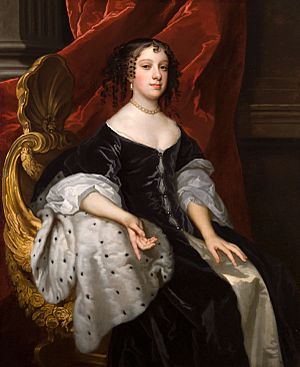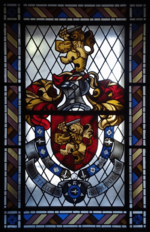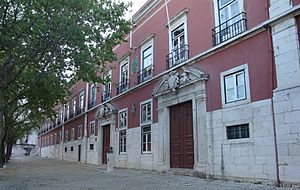Bemposta Palace facts for kids
Quick facts for kids Palace of Bemposta |
|
|---|---|
|
Palácio da Bemposta
|
|
 |
|
| General information | |
| Type | Palace |
| Architectural style | Neoclassical |
| Location | Pena |
| Country | Portugal |
| Coordinates | 38°43′24.58″N 9°8′17.46″W / 38.7234944°N 9.1381833°W |
| Opened | c. 1693 |
| Owner | Portuguese Republic |
| Technical details | |
| Material | Marble |
| Design and construction | |
| Architect | João Antunes |
The Bemposta Palace (Palácio da Bemposta), also known as the Queen's Palace, is a beautiful building in Lisbon, Portugal. It was first built for Queen Catherine of Braganza. She was the widow of King Charles II of England.
After living in London, Queen Catherine returned to Lisbon. She needed a home, so she had this palace built. For many years, it was her main residence. Later, it became a home for other members of the Portuguese royal family. Today, the palace is home to the Portuguese Military Academy.
Contents
History of Bemposta Palace

Queen Catherine of Braganza returned to Portugal in 1693. This was eight years after her husband, King Charles II of England, passed away. She was the daughter of King John IV of Portugal.
When she arrived in Lisbon, Queen Catherine did not have a permanent home. She stayed in different noble houses for a while. She then decided to buy land and homes in the Bemposta area. Her plan was to build her own royal residence there.
There was already a small chapel on the land from 1501. Queen Catherine asked the architect, João Antunes, to include a new chapel in the palace design. This new chapel was dedicated to Our Lady of the Conception.
The building project started in 1694. João Antunes joined the team in 1702. By that same year, the Queen had already moved into her new palace. The palace was built using a mix of materials. It had strong steel, wood, and stone. Marble was used for many of the fancy decorations.
Queen Catherine lived in the palace until she died on December 31, 1705. In her will, she left the Bemposta Palace to her brother, King Peter II of Portugal. A special royal chapel was also built in 1706.
In 1707, King John V of Portugal made the palace part of the Casa do Infantado. This was a special property for the younger sons and daughters of the Portuguese King. It became the home for many royal princes and princesses.
Rebuilding After the Earthquake
In 1755, a huge earthquake hit Lisbon. The Bemposta Palace was badly damaged, and its royal chapel was completely destroyed. The palace needed a lot of repair work.
Manuel Caetano de Sousa led the rebuilding efforts. The palace was fixed up, and a beautiful new chapel was built. This chapel had a rectangular entrance and main area. It was decorated with colorful mosaics.
The main altar of the chapel featured a painting of the Royal Family. It showed Queen Maria I of Portugal and Prince John VI of Portugal with their court. The painting also showed a view of Lisbon from the Castle of São Jorge.
The chapel's success was partly due to skilled woodworkers. They came from the Church of São Roque. The design of the chapel was also similar to the Royal Chapel at the Queluz National Palace.
The Bemposta Palace even had its own group of singers from 1759. They included an organist and singers who performed regularly. However, the organ was moved to the Queluz National Palace by 1778.
Over time, the royal family started to prefer other palaces. By 1798, the Bemposta Palace was left empty and began to fall apart.

A Royal Residence and Military Academy
In 1803, the Prince-Regent, who would later become King John VI of Portugal, lived at Bemposta. Even after the royal family returned to Portugal in 1821, King John VI chose to live at Bemposta.
He wanted to make the palace more comfortable. So, he ordered several renovations in 1822, 1824, and 1825. These changes mainly focused on the rooms behind the chapel and near the gardens.
Important political events happened at Bemposta during King John VI's reign. These included the Vila-Francada and Abrilada uprisings. King John VI also passed away in his private rooms at the palace on March 10, 1826.
In 1828, King Miguel of Portugal started holding his weekly meetings at the palace.
The palace stopped being part of the Casa do Infantado in 1833. It then became property of the Crown. For a short time, a government office used the palace. But in 1834, it was given back to the Crown under Queen Maria II of Portugal.
However, Queen Maria II later gave the palace to the Army in 1837. After 1851, it began to serve as an Army Academy. The building was greatly expanded and remodeled in 1850–1851. General Bernardo de Sá Nogueira de Figueiredo, 1st Marquess of Sá da Bandeira oversaw these changes.
In 1853, the chapel, which had been private, was opened to the public. As Lisbon grew, the area in front of the palace changed. The main outdoor staircase was shortened in 1860 to make way for a wider road.
The chapel had a full restoration in 1944. In 1997, the electrical and fire safety systems were updated.
In 1999, a detailed study of the palace's condition began. Today, the Bemposta Palace belongs to the Portuguese Military Academy. You can still see Queen Catherine of Braganza's coat-of-arms above the main doors.
In 2001, a monument to Queen Catherine was placed in front of the palace.
Architecture of Bemposta Palace
The Bemposta Palace is located in a square called Largo do Paço da Rainha. It is near the border of Pena and Anjos areas in Lisbon. The main building is used by the military academy. It faces the square, across from a clock-tower and another palace called Mitelo Palace. It is also close to a garden and a hospital.
The front of the palace has two grand staircases. They curve up to the main floor and a balcony with decorative railings. The main arched entrance is surrounded by two sets of tall windows. Above these, on the next floor, is another balcony with a central window. This window is taller than the others and has the royal family's sculpted coat-of-arms above it.
The top of this front wall has a triangular shape. It is decorated with a carving of two angels worshiping the Virgin Mary. This carving was made by the sculptor Joaquim de Barros Laborão. A cross sits on top of this triangular wall. Inside the chapel's entrance, there are two special areas with statues of Elizabeth of Portugal and John the Baptist.
The Palace Chapel
Inside the main chapel, there is a painting of the patron saint by José Troni. This painting also shows members of the Royal family in the front. These include Queen Maria I of Portugal, King John VI of Portugal, and Queen Carlota Joaquina. The English painter Thomas F. Hickey completed this work.
On the chapel's ceiling, in an oval shape, there is a painting of the Virgin Mary. This painting is believed to be by Pedro Alexandrino de Carvalho. Along the side walls, there are pulpits (raised platforms for speaking) with railings. On the left side, you can see the organ.
The side altars, except for one, have the initials of Pedro Alexandrino. On the roof, among a detailed Baroque scene, is another painting by Pedro Alexandrino. It shows the Assumption of Mary (Mary going to heaven). This painting is surrounded by angels and four important church leaders. The painter also created a painting of the Transfiguration of Jesus on the chapel's roof.
The sacristy, which is a room next to the main altar, is covered in colorful azulejos (painted tiles). It also has a special table made from Brazilwood.





